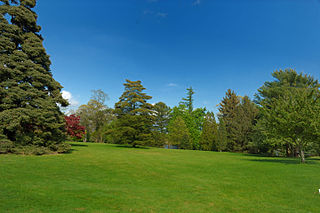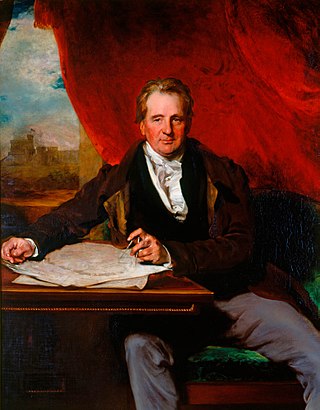Related Research Articles

Tresco is the second-biggest island of the Isles of Scilly. It is 297 ha (1.15 sq mi) in area, measuring about 3.5 km (2.2 mi) by 1.75 km (1.09 mi).

An arboretum is a botanical collection composed exclusively of trees of a variety of species. Originally mostly created as a section in a larger garden or park for specimens of mostly non-local species, many modern arboreta are in botanical gardens as living collections of woody plants and is intended at least in part for scientific study.

Bayard Cutting Arboretum State Park is a 691-acre (2.80 km2) state park located in the hamlet of Great River, New York, on Long Island. The park includes an arboretum designed by Frederick Law Olmsted for William Bayard Cutting in 1886, as well as a mansion designed by Charles C. Haight. Today Bayard Cutting Arboretum State Park is one of the last remaining estates on the South Shore of Long Island. It has been listed on the National Register of Historic Places since 1973 as a historic district. Robert Fulton Cutting, known as the “first citizen of New York” and his wife Helen Suydam Cutting, niece to Caroline Astor, would frequent the manor house and estate as both William and Robert were brothers. Together Robert and William brought the sugar beet industry to the United States.

Probus is a civil parish and village in Cornwall, England, in the United Kingdom. It has the tallest church tower in Cornwall. The tower is 129 feet (39 m) high, and richly decorated with carvings. The place name originates from the church's dedication to Saint Probus. The parish population at the 2011 census was 2,299, whereas the ward population taken at the same census was 3,953.

The Field Elm cultivar Ulmus minor 'Viminalis Pulverulenta' (:'powdery'), also known as 'Viminalis Variegata', a variegated form of U. minor 'Viminalis', was first mentioned by Dieck, in 1885 as U. scabra viminalis pulverulentaHort., but without description. Nursery, arboretum, and herbarium specimens confirm that this cultivar was sometimes regarded as synonymous with U. minor 'Viminalis Marginata', first listed in 1864, which is variegated mostly on the leaf margin. It is likely, however, that 'Pulverulenta' was the U. 'Viminalis Variegata', Variegated Twiggy-branched elm, that was listed and described by John Frederick Wood, F.H.S., in The Midland Florist and Suburban Horticulturist 1847 and 1851, pre-dating both Kirchner and Dieck. Wood did not specify the nature of the variegation.
Sir Christopher Hawkins, 1st Baronet, FRS was a Cornish landowner, mine-owner, Tory Member of Parliament, and patron of steam power. He was Recorder of Grampound, of Tregony, and of St Ives, Cornwall.
Longstock Park is in the civil parish of Longstock in the Test Valley district of Hampshire, England, and forms part of the Leckford Estate, wholly owned by the John Lewis Partnership.

Sir Jeffry Wyatville was an English architect and garden designer. Born Jeffry Wyatt into an established dynasty of architects, in 1824 he was allowed by King George IV to change his surname to Wyatville. He is mainly remembered for making alterations and extensions to Chatsworth House and Windsor Castle.

Holmbush is a village in Cornwall, England that is situated in the suburban area of St Austell. It was a centre for tin and copper mining in the eighteenth and nineteenth centuries, with a few houses to the south of the A390 road. It was developed in the 1970s, with the construction of housing and an industrial estate to the north of the road. Since 1974, the site of Cuddra mine has been developed as Pinetum Gardens, an attraction holding over 6,000 varieties of plants, many collected by the owner on plant hunting expeditions.
Tresco is a civil parish in the Isles of Scilly, Cornwall, England. The parish contains 16 buildings that are recorded in the National Heritage List for England as designated listed buildings. Of these, two are listed at Grade II*, the middle grade, and the others are at Grade II, the lowest grade. The largest island in the parish is Tresco, and the parish also includes Round Island with its listed lighthouse. The oldest listed building consists of the ruins of a Benedictine priory dating from about 1300.T he island had a strategic importance and this is reflected in its three listed fortifications. In the 19th century, a country house, Tresco Abbey, was built close to the ruins of the priory, and its grounds have been transformed into Tresco Abbey Gardens. Listed buildings in addition to those mentioned above include houses, farm outbuildings, a church, a monument, and the wall of a former kelp pit.
References
- ↑ Some entries based on Synge, Patrick M. (1977) The Gardens of Britain; Vol. 1: Devon and Cornwall. London: B. T. Batsford in assoc. with Royal Horticultural Society ISBN 0-7134-0927-4; pp. 83-147
- ↑ The Longcross Hotel; Gardens
- ↑ Mary Newman's Cottage; Cornwall Museums
- ↑ Busbridge Lakes Home Page